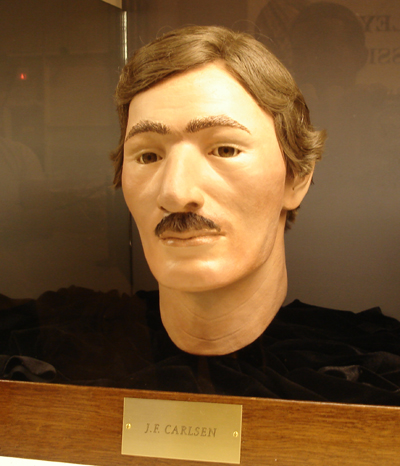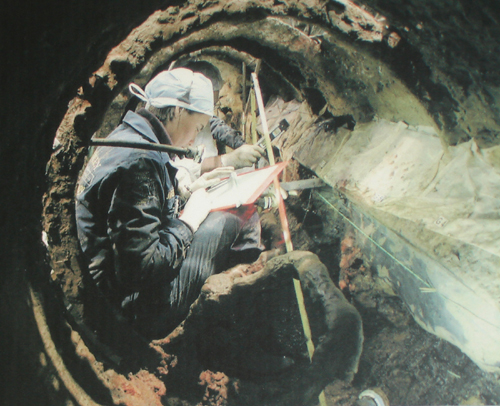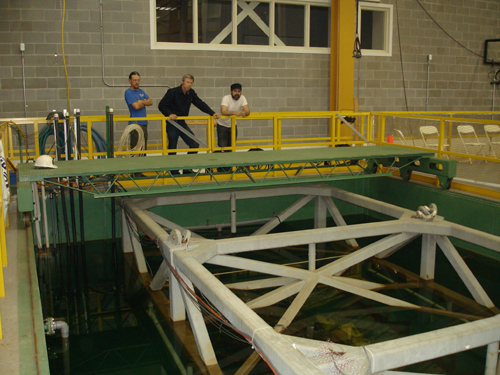
Forensic facial reconstruction of J.F. Carlsen, former helmsman on the Jefferson Davis who perished on the H.L. Hunley submarine offshore Charleston, South Carolina.
This information comes from a LAMP volunteer about the crew of the Jefferson Davis which sank off the bar in St. Augustine to the north of the lighthouse.
Corporal J. F. Carlsen
(April 15, 2004 – CHARLESTON, SC)
J. F. Carlsen was a European by birth. He seems to have been drawn to danger and adventure. Before he lost his life on the H. L. Hunley at approximately 20-23 years of age, he had crossed the Atlantic, run the blockade surrounding the South, and been part of a crew taken over by a mutiny. He was also recognized for bravery during fierce battles for his service to the Confederacy.
In addition to his young age and European origin, forensic analysis also confirms that Carlsen was about 5 feet 10 inches tall. Forensic genealogist Linda Abrams has traced Carlsen’s history in America to 1861, when he was helmsman onboard the Jefferson Davis, a privateer ship based out of Charleston, with a black hull, masts, and sails. Privateers captured enemy merchant vessels, took on their crew, and returned to port to sell captured goods.
On June 28, 1861, the Jeff Davis sailed from Charleston, South Carolina. During this voyage, the privateer captured seven merchant ships and their crews. After such a successful run, captured crewmen eventually outnumbered the men of the Jeff Davis, and the captives attempted to take over the ship. The crew survived, but the conflict caused the ship to be lost near St. Augustine, Florida in August of 1861.
Though the crewmen who revolted on the vessel were captured, the laws still looked upon this action as mutiny, a serious crime in the 19th century. In September of 1861, members of the Jeff Davis crew, including Carlsen, returned to Charleston and filed charges of treason at the Courthouse against the men who led the revolt.
During the trial that followed, Carlsen signed witness statements. Those documents have enabled Abrams to confirm the correct spelling of his name, which had not been previously known.
“Tracking down the crew can be like searching in the dark. You can’t always trust historical accounts of the spelling of a name. There are some accounts of Carlsen’s name being spelled with different initials, and with an ‘o’ instead of an ‘e’ in his last name, which made it very difficult to track down information about his life,†Abrams said.
During the time Carlsen was testifying in the mutiny trial in Charleston, the German Artillery was stationed in nearby Green Pond (Colleton County) and was actively recruiting members. Since Carlsen was not a native of South Carolina, he was most likely not subject to conscription laws. He became one of the recruits, volunteered for the artillery and was later recognized for his bravery at the Battle of Fort Walker in Hilton Head, South Carolina in November of 1861.
Carlsen stayed with the German Artillery through 1864. In early 1864, Carlsen became one of the men who volunteered for service on the Hunley. Several accounts say Hunley Commander Lt. George Dixon found two crewmembers in the German Artillery, and used one to replace William Alexander, an engineer from Mobile that came to Charleston to help Dixon man the submarine. Alexander had helped build the vessel and had experience navigating the Hunley in test runs in Mobile Bay.
Carlsen was assigned to the fourth crank handle, a dangerous spot in case of an emergency evacuation. He was most likely assigned this position because he was the newest member of the crew and the least familiar with its operation.

Carlsen’s leather wallet, found among his remains on board Hunley, before and after conservation.
Based on documents found to date, Carlsen’s official military records indicate he died on the Hunley. Absent from his unit when the Hunley disappeared after sinking the USS Housatonic, the muster roll states that Carlsen was “…lost in the Submarine Torpedo Boat on the 16th, [17th], of Feb 1864 while in the act of sinking the U.S. Steamer Housatonic.â€
On February 17, 1864 the brief but intense adventures of a young life ended for J. F. Carlsen. His boldness and bravery, however, earned him a permanent place in maritime history.
On the evening of February 17, 1864, the H. L. Hunley became the world’s first successful combat submarine by sinking the USS Housatonic. After signaling to shore that the mission had been accomplished, the submarine and her crew of eight vanished.
Lost at sea for over a century, the Hunley was located in 1995 by Clive Cussler’s
National Underwater Agency (NUMA). The hand-cranked vessel was raised in 2000 and delivered to the Warren Lasch Conservation Center, where an international team of scientists are at work conserving the vessel and piecing together clues to solve the mystery of her disappearance.

Archaeologists at work inside the hull of the Hunley at the Warren Lasch Conservation Laboratory in Charleston.
The Hunley project scientific staff worked with forensic expert Doug Owsley of the Smithsonian Institution and forensic genealogist Linda Abrams to identify the remains of the Hunley crewmembers. They did this by combining the archaeological and genealogical information with the osteological analysis of the skeletal remains. For example, the remains can tell us the age range and region of origin for each crewmember. If the genealogical information on age and birthplace match the forensic data, they can estimate the crewmember’s identity through the process of elimination. However, a completely positive identification of each crewmember can only come from a DNA match with a descendent. See: http://www.hunley.org/main_index.asp?CONTENT=press&ID=118

LAMP archaeologists Brendan Burke and Sam Turner, along with Hunley archaeologist and conservator James Hunter, gaze down upon the Hunley, in fresh water and still supported by the lifting cradle which carefully removed it from the seafloor. This and other photos are provided courtesy of the Warren Lasch Conservation Laboratory.

